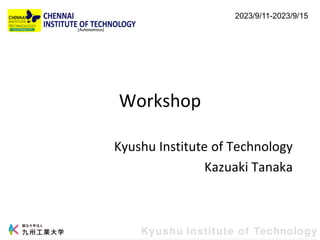workshop slide.pdf
- 1. Workshop Kyushu Institute of Technology Kazuaki Tanaka 2023/9/11-2023/9/15
- 2. ? šÝšÝßĢ ? Programming environment https://bit.ly/3Rep87m https://bit.ly/45InC1H
- 3. About Me ? Kazuaki TANAKAĢĻĪŋĪĘĪŦ ĪŦĪšĪĒĪĢĐ ? Kyushu Institute of Technology, JAPAN Associate Professor ? Ph. D in Information Science ? Research topics: embedded systems, IoT, mruby, wireless communication
- 5. Our Campus Kyushu Institute of Technology
- 6. Research topic: mruby and mruby/c ? Ruby language for small devices ? OO Programming Language ? Target: one-chip microcontroller PIC, ESP32, STM32, etc. ? Small memory footprint minimum 20KB ? Open-Source Software https://github.com/mruby/mruby https://github.com/mrubyc/mrubyc
- 7. What is Ruby language? ? Object Oriented Programming Language ĻC Scripting language ĻC Web application, Ruby on Rails ? Matsumoto has said that Ruby is designed for programmer productivity and fun. led1 = GPIO.new(0) while true do led1.write 1 sleep 0.5 led1.write 0 sleep 0.5 end Ruby code example:
- 8. Research topic: wireless communication ? LPWA(Low Power Wide Area) communication network
- 9. LPWA ? Long range wireless communication ĻC ~10km by small wireless module ĻC Using 920MHz band 24mm 17mm Low power Tx: 43mA Rx: 20mA Sleep: 1.7ĶĖA Speed: 1kbps
- 10. Introduction
- 11. This workshop ? Experience in embedded software development. ? mruby programming ? Controlling electronic circuits ? Brightness sensor
- 12. Simple Circuit
- 13. Electrical circuit ? Micro controller board ? Electrical parts and circuit ĻC LED, sensors ĻC Breadboard (prototyping board)
- 14. Run the first program ? Coding ? Compile and Download Download= transfer compiled program into microcontroller board ? Execute
- 15. Programming environment ? Open following URL or https://mrubyc-ide.ddns.net/editor/rboard https://bit.ly/45InC1H
- 16. Blinking LED ? program1 ? First, run this program led1 = GPIO.new(0) while true do led1.write 1 sleep 0.5 led1.write 0 sleep 0.5 end
- 17. Microcontroller board ? RBoard ? Features ĻC Execute program ĻC Store data ĻC I/O of Pins ĻC Input= Measure voltage ĻC Output= Set voltage HIGH(1) or LOW(0) Pin
- 18. Onboard LEDs ? 4 LEDs, each LED is connected to Pin ĻC LED 1: Pin 0 ĻC LED 2: Pin 1 ĻC LED 3: Pin 5 ĻC LED 4: Pin 6 ? Set pin voltage to HIGH, then turn on LED Set to LOW, then turn off LED
- 19. Program ? GPIOĢš General Purpose Input and Output led1 = GPIO.new(0) while true do led1.write 1 sleep 0.5 led1.write 0 sleep 0.5 end Pin0 is assigned to variable led1 Iteration write: set voltage sleep: stop execution
- 20. Exercises ? Blink two LEDs alternately ? Blink four LEDs LED 1: Pin 0 LED 2: Pin 1 LED 3: Pin 5 LED 4: Pin 6
- 21. LED ? Light Emitting Diode Current flows from Anode to Cathode Longer: Anode Anode Cathode
- 22. LED Circuit ? Make LED on ĻC Current flowing through the LED ? Rboard feature ĻC Set voltage of Pin ĻC Set HIGH or LOW
- 23. Wrong circuit Board Pin (HIGH) Pin (LOW) LED The resistance of LED is almost 0. Many current flows, cause damages to LED
- 24. LED circuit Board Pin (HIGH) Pin (LOW) LED Resistor 1K ohm Resistor limits current flowing.
- 25. LED circuit Board Pin (HIGH/LOW) GND LED Resistor 1K ohm GND is always LOW LED on if Pin is HIGH LED off if Pin is LOW
- 26. Breadboard (Prototyping board) ? Red holes are connected
- 27. Using breadboard ? Connecting a LED and a resistor LED Resistor Longer leg Shorter leg
- 29. Connecting ? Use jumper wires Pin 15 GND LED Resistor Pin ĢąĢĩ GND
- 30. Implement your code led1 = GPIO.new(15) led1.setmode(0) while true do led1.write 1 sleep 0.5 led1.write 0 sleep 0.5 end Set pin mode 0: Output voltage 1: Input voltage Pin 15
- 31. Exercises ? Blink several LEDs on breadboard You can use Pin15, Pin16, Pin17, Pin18, Pin19, Pin20
- 32. PWM
- 33. PWM Analog output ? Output of microcontrollers: Digital ĻC HIGH or LOW voltage ĻC In LED, ON or OFF ? We want: Analog ĻC Change voltage ĻC In LED, ONĄbrightĄdarkĄOFF
- 34. Pseudo analog output ? PWM, pulse width modulation ? Control HIGH and LOW rapidly ĻC 1000 times a second 0.1 msec. 50% HIGH 50% LOW
- 35. Change brightness ? Change brightness => Change duty ratio Time 1 msec. Duty=1 Duty=2 Duty=1023 Duty=1022 Duty=1 Duty=0 Duty=0
- 36. PWM example led1 = PWM.new(15) led1.frequency 10000 while true do for i in 0..1023 do led1.duty i sleep 0.001 end for i in 0..1023 do led1.duty 1023-i sleep 0.001 end end duty: 0 to 1023 0: 0% HIGH 1023: 100% HIGH
- 38. CdS ? CdS: Resistance changes with varying light levels. ? Microcontroller can detect VOLTAGE
- 39. CdS circuit CdS 3.3V Pin20 GND Resistor 1K ohm R ohm Bright: small R Dark: large R ???20 ??????? = 3.3 ĄÁ 1? 1? + ?
- 41. ADC ? ADC: Analog Digital Converter ĻC Read voltage at Pin20 ĻC Voltage v 0 < v < 1.5 adc = ADC.new(20) v = adc.read
- 42. CdS example led1 = GPIO.new(0) adc = ADC.new(20) while true do v = adc.read if v<0.5 then led1.write 1 else led1.write 0 end sleep 0.1 end Read voltage from Pin20 Voltage: 0 < v < 1.5 Pin20 for ADC
- 43. Exercises ? Brightness sensor ? LED changes by brightness ĻC Green: bright ĻC Yellow: a little dark ĻC Red: dark ? adc.read returns around 0.2 in dark, and returns around 0.9 in bright
- 44. Conclusion
- 45. Embedded systems ? Software and Hardware integration ? Software controls hardware ĻC Requires both software and hardware knowledge














































